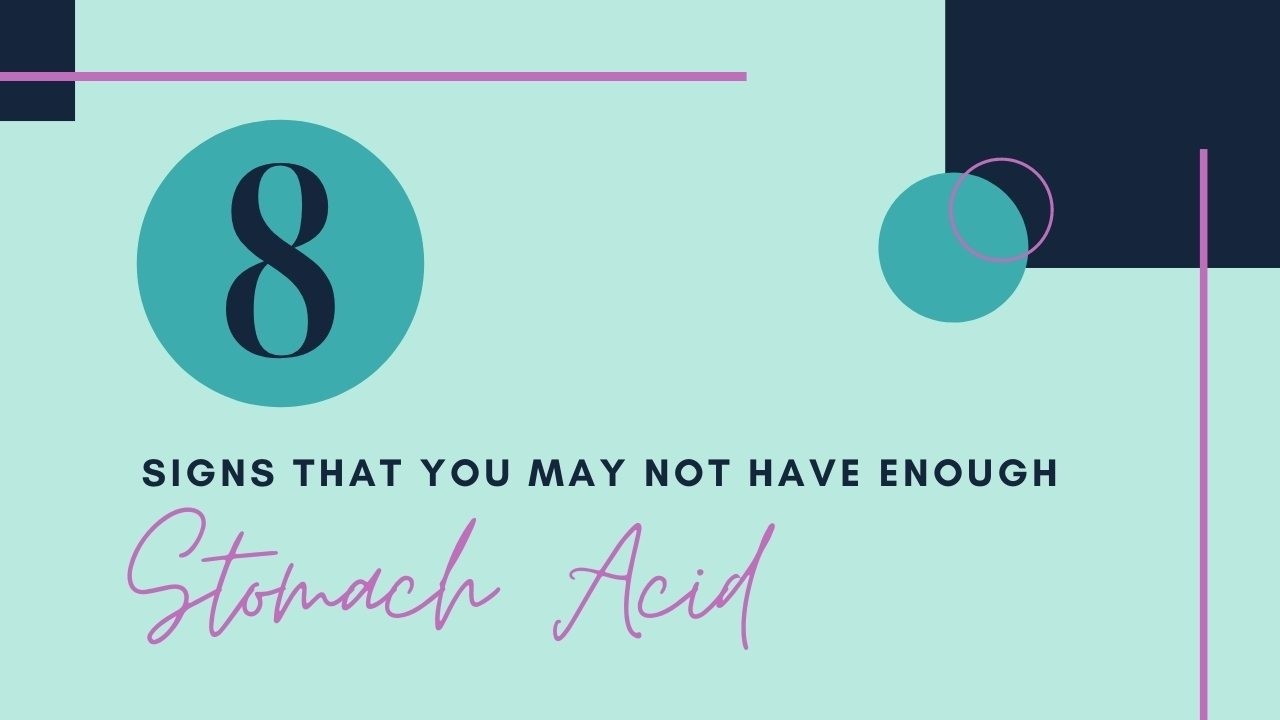
8 Signs That You May Not Have Enough Stomach Acid
May 10, 2022You may be surprised to learn that these symptoms could be related to low stomach acid.
It is believed that nearly 90% of the population does not have an adequate amount of stomach acid. Stomach acid, AKA hydrochloric acid (HCl) is produced by the parietal cells of the stomach. Hydrochloric acid plays not only a significant role in the proper digestion and absorption of nutrients in our food but also protects again pathogens and bacteria that may be consumed.
North-to-South Digestion
Digestion can be viewed as a north-to-south process, starting with the mouth and ending at the anus. The digestive events that start in the “north” can positively or negatively impact the digestive events that occur in the “south”. Digestion is a domino effect of events that are triggered by the previous digestive event. In particular, a deficiency of stomach acid can significantly inhibit proper digestion. You can learn more about the importance of stomach acid in a recent blog post found here. In the meantime, here are 8 symptoms commonly associated with low stomach acid levels.
Insufficient Stomach Acid Symptoms
1. Gas and Bloating
Gas and bloating are probably the most common GI complaints but the underlying root cause can be difficult to determine just on symptoms alone. Not having enough stomach acid can allow for the overgrowth of opportunistic or pathogenic bacteria or fungi as the bacteria feed on the undigested food molecules. Bloating can especially become problematic when the bacteria that predominately occupy the colon are now residing in the small intestine. This is known as small intestinal bacterial overgrowth.
2. Feeling Excessively Full
The opening between the stomach and the small intestine, known as the pyloric sphincter, will open to allow the passage of the ball of food (chyme) when the pH of that food is between 1.5-3. Without sufficient stomach acid, the pylorus does not open and the food will not pass. The pylorus can be forced open with the consumption of more food (however the improper pH does not trigger the appropriate release of digestive enzymes and bile). This can lead to feeling full early in a meal or that hungry but full feeling many experience.
3. Heartburn or Acid Reflux
It’s a very common misconception that experiencing heartburn or acid reflux is due to having too much stomach acid. However, having adequate stomach acid is one of the mechanisms that will trigger the opening between the esophagus and stomach, AKA the lower esophageal sphincter (LES) to close properly. Without proper closure of the LES, stomach acid can reflux up the esophagus.
4. Constipation and/or Diarrhea
These symptoms, like gas and bloating, are also very common GI complaints that could have multiple underlying root causes. Appropriate stomach acid levels can ward off pathogenic bacteria or pathogens that can disrupt the balance of the microbiome and trigger the symptoms of constipation or diarrhea.
5. Food Allergies or Sensitivities
Intestinal permeability, AKA leaky gut, occurs when the tight junctions of the intestinal lining become inflamed and loose. With low stomach acid, the food that is consumed is not digested to the microscopic levels for absorption. These food particles, along with toxins and bacteria, now leak into the bloodstream. That food is no longer viewed as a nutrient source but rather a threat when it is in the body stream. Antibodies to those foods are formed in response, creating food allergies or sensitivities.
6. Weak and/or Brittle Hair and/or Nails
Stomach acid is not only needed to denature protein into our body’s building blocks - amino acids - but it is also needed to liberate the nutrients from the foods you are consuming. Iron, in particular, is necessary for hemoglobin to deliver oxygen to hair, skin, and nails. People with deficient acid production absorb iron even more poorly than normal individuals.1 In addition, stomach acid is needed to trigger the release of bile from the gallbladder to emulsify fats. Improper digestion of fatty acids can also lead to weak/brittle hair and nails.
7. Difficulty Digesting Meat
I think you’re getting the picture here but without stomach acid, you will have a challenging time digesting animal protein. Often this can turn people towards a plant-based diet as they experience increased GI symptoms while eating meat. However, I would caution you with this option as a vegan/vegetarian-based diet does not improve stomach acid levels and you can miss out on key nutrients the body needs.
8. Seeing Undigested Food in Your Stools
When the food in the stomach (chyme) reaches a pH of 1.5-3 the pyloric sphincter opens and allows for the passage of the food to the small intestine. While the small intestine secretes mucus to protect the intestinal lining, it is also signaling to the pancreas to release digestive enzymes. Without a proper low pH of the chyme, the digestive enzymes are not secreted to continue breaking down the food, hence seeing undigested food in your stool.
In conclusion, if you find yourself checking some of the boxes for these symptoms, it’s time to explore if low stomach acid is affecting your health status. There are a few different test options available to explore your acid levels, two of which are free or relatively cheap. You can learn more about the at-home options here.
The information available on this website is for general health information only and is not intended to be a substitute for professional medical advice, diagnosis or treatment. You should not rely exclusively on information provided on the Website for your health needs. You can read more about our disclaimer here.
Resources:
1. https://www.sciencedirect.com/topics/immunology-and-microbiology/stomach-acid
Are you overwhelmed by all of the conflicting information regarding health, hormones, nutrition, and weight management?
Join me once a month for a FREE "Ask Me Anything" live Zoom sesh! I'll answer all the questions you've been spending so much time searching the internet for.









